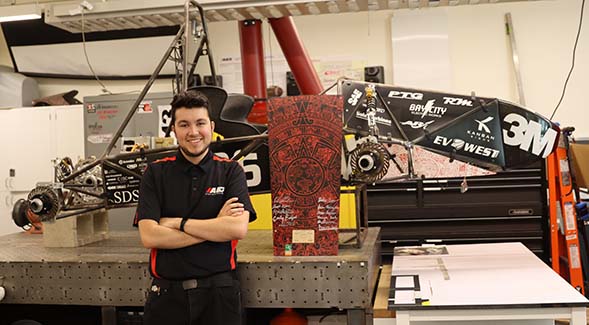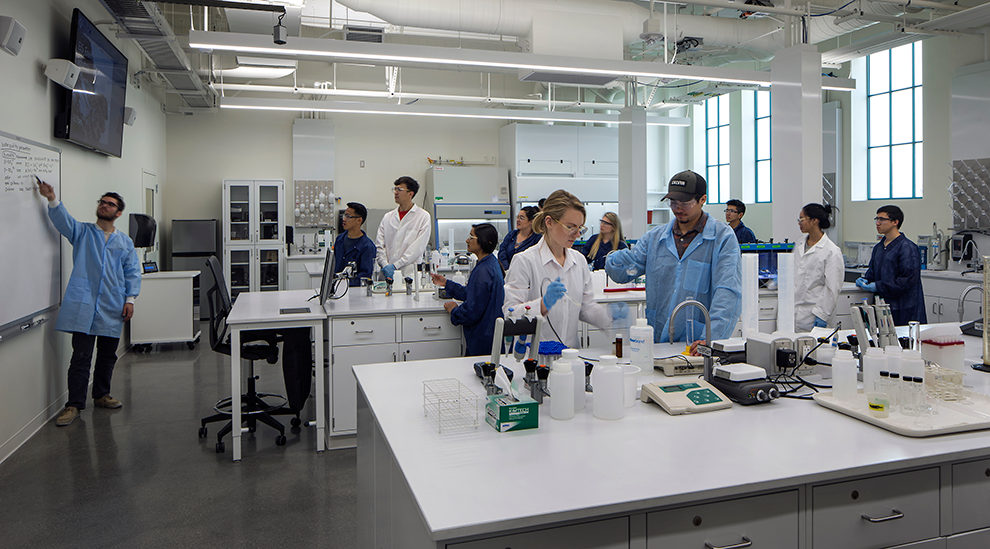SDSU's Spirit of Innovation Award Goes to Longtime EV Enthusiast
Juan Rojas has been involved with the Aztec Electric Racing club since his first year. In June, the club puts its project to the ultimate test.

Updated June 23, 2022
One month after he walks for graduation, Juan Rojas hopes to see his time at San Diego State University achieve fulfillment on wheels as well.
Four years of work with the Aztec Electric Racing Club have led the mechanical engineering major to the driver’s seat for SDSU’s entry in an international collegiate challenge — and his selection for the university’s 2022 Zahn Spirit of Innovation Award.
Innovation was a big reason behind Rojas’s involvement with the club, including two years as president, and its development of the battery-powered vehicle for this year’s competition.
“It’s something new … and with enough development in e-technology you can find a way to improve society, the economy, the environment — make it more equitable so everyone can afford it,” Rojas said in an interview in April as the race car was still being assembled in a ground-floor workshop at the Engineering and Interdisciplinary Sciences Complex.
“I chose to look into the EV field because I felt that was one way that if that technology gets developed enough, it’s not just a luxury car, it’s a car for everyone that can really impact not just the local community but the nation and even the globe.”
SDSU’s Spirit of Innovation Award recognizes a graduating senior who has shown exceptional entrepreneurial achievement as an undergraduate. Funded by Irwin Zahn and the Moxie Foundation, the award is now in its seventh year and comes with a scholarship. This is the second time a mechanical engineering student has won.
Rojas’s studies also landed him a job at Solar Turbines, which started in San Diego in 1927 as an aircraft company and is now involved in electric power generation. Rojas interned last summer at the company’s Harbor Drive site, where “they let me explore (and) take on new projects,” and was hired on as a manufacturing engineer associate two weeks after submitting his application.
But for now, he’s still thinking about the Society of Automotive Engineers (SAE) International competition, scheduled for June 15-18 in Brooklyn, Michigan, about 90 minutes southwest of Detroit.
About 65 student-designed and -built vehicles will compete in open-wheel, single-occupant vehicles. Rojas expects to drive SDSU’s vehicle, which sports a hood panel with the familiar Aztec calendar design seen on the school’s football helmets.
It’s Aztec Electric Racing’s fourth trip to the Olympics of electric-car racing, but they’ve never made it to the main event. In 2019, the car was disqualified over an issue with specifications for the battery pack.
“It was at that competition that we failed and I thought to myself, I really want to see this team succeed, I'll do whatever it takes, spend as many hours as I can to ensure the success of this team,” said Rojas, who plans to stay in touch after this year as an adviser to AER and its more than 20 members.
The 480-pound car, which reuses assorted parts from 2019 and goes by the no-nonsense name of AER-21, is expected to have a top speed of about 45 mph. It will race on a 14-mile road course for the endurance event, with a clearance of just 1.5 inches above the ground. The battery pack puts out 350 volts. (Update: The team made it to the event but was unable to compete in the race due to problems with the vehicle's circuit boards.)
The competition comes with some high-powered financial support, too. Richard Woodcock, a psychometrician with a history of support for College of Engineering initiatives, provided $100,000 for AER. Other major donors with skin in the EV game include 3M, Altium, Siemens and Tesla. The team also received $75,000 from SDSU’s Student Success Fee program.
Hala Madanat, interim vice president for research and innovation, congratulated Rojas and said the university “can’t wait to see all that you accomplish.”
“This award is about recognizing students who go the extra mile to be innovative, who apply their first-class SDSU education to new and novel endeavors, and who, when they fail, try again,” Madanat said. “Juan embodies all that and much, much more."
Rojas is a first-generation college student and grew up primarily in South County communities — San Ysidro, Imperial Beach and Chula Vista — where environmental issues often rise a little closer to the surface. The term “environmental justice” wasn’t widely used at the time, but Rojas remembers low-income neighborhoods dominated by 10- and 15-year-old vehicles that weren’t always easy to keep running.
So what kind of car does the electric vehicle devotee own today? He doesn’t. Rojas gets around by public transportation, taking the MTS 215 bus to campus from Normal Heights. The job at Solar will be accessible by trolley.



